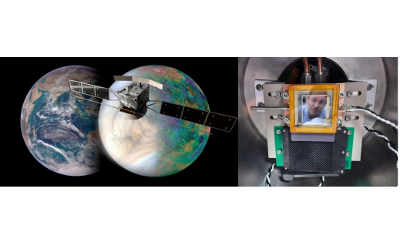You are here
- Home
- £2.3M grant awarded to Professor Manish Patel for the next European space mission to Venus
£2.3M grant awarded to Professor Manish Patel for the next European space mission to Venus

The Open University (OU) Atmospheric research and Space exploration group, led by Professor Manish Patel, has been awarded a £2.3 million grant from the European Space Agency (ESA) to help develop instrumentation for the EnVision mission to Venus in 2032.
The EnVision mission will unravel the secrets of Venus hidden below its thick cloud layer, and marks the beginning of a golden-era of Venus exploration in the 2030s. EnVision will determine whether Venus is geologically active and provide the first-ever global observations of the atmospheric composition from surface to top of its atmosphere, and its evolution over time.
Researchers at The Open University are involved in the design and development of the VenSpec-U instrument, which is a UV spectrometer investigating the atmospheric sulphur chemistry and seeking to identify the unknown UV absorber in the Venus atmosphere. The OU space research team led by Professor Patel will be leading the testing and characterisation of the detectors that will be at the heart of the VenSpec-U instrument, and participating in science preparations for the mission and eventual science exploitation of the VenSpec-U data in the 2030s.
The award of this major funding to the OU is the latest in a series of awards that demonstrate our space-related research excellence. This long-term funding enables our strategic research ambitions for the coming decade – we are already world-leaders in Mars atmospheric and surface science – we are now going to do the same for Venus. All of this is enabled through the research excellence of our project officers, postdocs, and students
Professor Manish Patel
Part of what makes Venus a compelling planet to explore is in how it compares to Earth. Venus and Earth provide two extreme examples of how relatively similar planets can diverge in their evolution into such different environments – the clement environment of Earth, compared to the hellish high temperature, high pressure and sulphuric acid rain encountered on Venus. Venus thus serves as a natural laboratory to study the evolution of habitability in terrestrial planets and the runaway greenhouse effect and also provides information that may be essential to interpreting observations of terrestrial-like planets beyond our own Solar System.
One of the project officers who is helping to make the technological strides necessary for conducting this research is Dr Nyasha Suliali, part of Profesor Patel’s team and a member of the OU Centre for Electronic Imaging (CEI).
It is a great honour to work on this space mission, and very exciting to be part of the multidisciplinary, dynamic team that is developing the technical infrastructure for such a project. Especially, to know that one day the detectors that I am testing in our laboratory will be orbiting Venus as part of a global endeavour to explore this mysterious planet. This award speaks to the exceptional competence of the CEI in space imaging detector development.
Dr Nyasha Suliali
The OU team working on this project includes Professor Manish Patel, Dr Konstantin Stefanov, Jon Mason, Dr James Ivory, Dr Nyasha Suliali, Martyna Hodges, Dr Martin Prest, Dr Mark Leese, Charlotte Marriner and Marian Cattermole.
Quarterly Review of Research
Read our Quarterly Review of Research to learn about our latest quality academic output.

Contact our news team
For all out of hours enquiries, please telephone +44 (0)7901 515891
Contact details